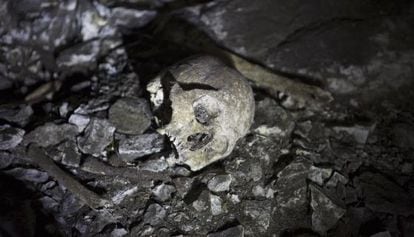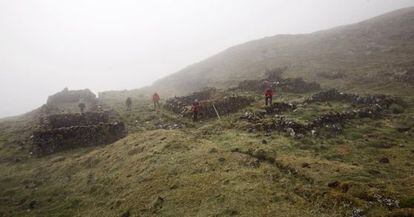Spanish team finds Inca ruins that may have been site of human sacrifice
A total of 55 buildings and a cemetery have been located in Vilcabamba, Peru

Four expeditions, a hunch, and meticulous satellite tracking work have led to the discovery of an Inca sanctuary in the mountains of Vilcabamba in Peru, 150 kilometers above the northeastern city of Cusco.
The team of Spanish scientists and researchers led by the writer and explorer Miguel Gutiérrez Garitano have just returned to Vitoria, still shocked about the “importance” of their finding, which includes at least 55 sites in the “highest mountain in the area, in a place where they could only be found by satellite imaging.”
The evidence we have collected may show proof of the existence of human sacrifices in the high mountain area”
Gutiérrez Garitano can barely hold back his surprise and joy: “The ruins, unknown to science until now and discovered through an investigation that included remote sensing techniques, may be from the Inca kingdom of Vilcabamba. The evidence we have collected may show proof of the existence of the ritual Capacocha, or human sacrifices, in the high mountain area, which – according to experts – would be a revolutionary discovery. Moreover, very luckily, we also found an Inca cemetery with dozens of tombs inside caves,” the explorer said.

Archeological fieldwork
Computer hardware company Mars Gaming was one of the sponsors of the fieldwork, which took place in mid-September. “We climbed up the mountain, up to the summit, and we covered the most important areas that we had identified via remote sensing technology [They found 30-50 locations]; the results exceeded our expectations. We were able to photograph various rectangular sites that seem like buildings that were probably used for worship or associated with it (like inns or dwellings set aside as lodging for those participating in rituals), besides Inca roads, stairs and altar steps, outfitted caves, huacas [carved stone artifacts], usnus [platforms] and a number of tombs at the foot of the mountain,” Gutiérrez Garitano said. The archeologist Iñigo Orue says “the entire mountain is organized like a huge site whose potential we cannot know before more archeological exploration.”
Usually this type of ritual — where they mainly sacrificed virginal maidens – was performed to prevent famines”
Experts say that the Inca carried out important rituals on this mountain, one of the main holy sites during the Neo-Inca kingdom in Vilcabamba, though it may have been built before. These ceremonies may have included human sacrifices, or Capacocha. “Usually this type of ritual — where they mainly sacrificed virginal maidens but not necessarily only those – was performed to prevent famines or natural disasters, during some specific festivals or after the death of the Inca, for example,” the explorer continued.
“We have found evidence indicating that the ritual of Capacocha may have been performed on this mountain. We have documented two building structures near the summit identical to those that emerged from the volcano Llullaillaco and that were supposedly used to prepare the children before the last ritual of the sacrifice. There is a stone platform nearby where those children may be buried.”
The team hopes to return to Peru in the summer of 2016 to expand on what it has learned.
English version by Dyane Jean Francois.










































